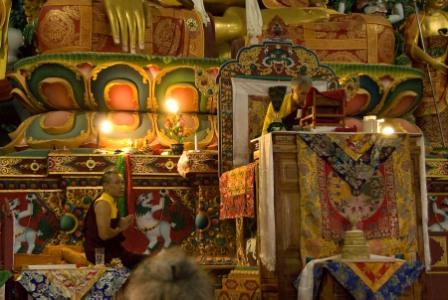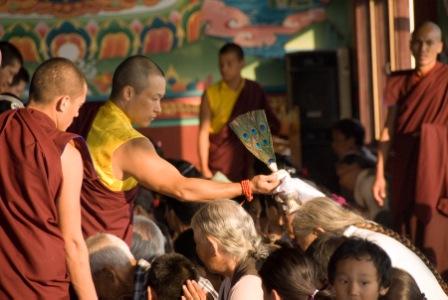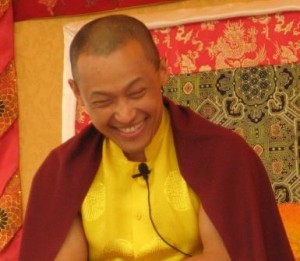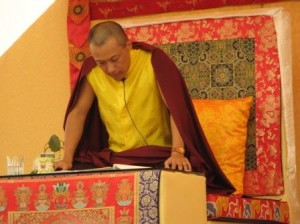Friday
Dharma TeachingsLongevity Supplication for Sakyong Mipham Rinpoche
Because the experience of chanting is very personal and the images are intended to be provocative, we offer this essay with the intention of starting a conversation. Please do contribute your reflections in the comments section.

Sakyong Mipham with Namkha Drimed, the author of the longevity supplication, at the Rinchen Terdzo. Photo by Christoph Schoenherr.
Longevity supplications are also a way to stimulate a continuing awareness of the guru principle in general and the “outer” and “inner” guru principles in particular. The outer guru is the one we see and study with. Because we initially find it easier to recognize enlightened mind in someone else, the outer guru’s example makes it easier to later recognize the “inner” guru in ourselves. What we are talking about here is a spacious, warm, awake and aware quality that normally exists un-noticed in the background of our daily experience. It is this quality that devotion to the outer guru gradually helps to bring to the foreground of our experience as we travel on the path.
Longevity chants can often seem “over the top” with superlatives about the guru. This one is no exception. We praise the guru’s limitless good qualities, and ask him to stay around teaching us for eons. We aspire for him to accomplish unbounded buddha activity. There is a reason for this limitless quality. Essentially, what we are talking about is buddha nature—our own and the guru’s. Buddha nature is connected with emptiness, which includes emptiness of limits. Individual appearances that come into our awareness are temporary and dependent on conditions, but the mind itself is like a vast emptiness from which anything can arise. Buddha nature is connected with the intelligent, awake and aware quality of mind at that level. So what we are praising is buddha nature’s limitless potential, first in the guru and by implication in ourselves and other sentient beings.
The chant opens with the words “OM SVASTI”. Svasti could be translated as “good”, or “auspicious” or “wonderful”. So the opening could mean something like “Ah, wonderful”. The next lines invoke the blessings of deathless Amitāyus. Amitāyus is the buddha of the western pure land, Sukhāvatī. Prior to becoming a buddha, Amitāyus is said to have vowed to create an ideal place for practice and awakening, one that could be easily reached by ordinary people through the power of aspiration. He is connected with the padma energy of warmth and compassion. Amitāyus is frequently called on in the context of longevity practices or when we make aspirations for a recently deceased person to be reborn in his pure land.The following lines in the chant praise the Sakyong’s role as a lineage holder of three great teaching streams: that of Padmasambhava, Mipham the Great, and the Shambhala lineage.
The first line in the body of the chant invokes power of the truth of the long-life vidyādhara Padmākara, his consort, and so forth. Padmākara is another name for Padmasambhava, who was instrumental in establishing Buddhism in Tibet. Tibetans revere this eighth century master as the ultimate rinpoche, or “Guru Rinpoche”. Padmasambhava had several consorts, so it’s not clear which one is being called upon here. We can guess that it might be Yeshe Tsogyal, the most well known to us. Besides invoking Padmasambhava’s blessings and that of his consort, the chant also invokes the blessings of the assembly of “those who have attained deathlessness”. Attaining deathlessness is one of the four attainments of a yogin who reaches the level of vidyādhara. Deathlessness could be understood literally– that Padmasambhava and the vidyādharas are still alive, just not visible to ordinary people. Or, it could be understood in the sense that the essence of their minds, like space, cannot be destroyed.
The following lines contain some traditional Tibetan word play. The Tibetan writer of a longevity supplication, in this case the Sakyong’s father-in-law, Namka Drimed Rabjam Rinpoche, will often find a way to incorporate a word whose meaning somehow connects back to the name of the person we are supplicating to live a long life. In this case, the words with double meanings are italicized. “Ruler of the three worlds, protector who guards our well-being….” The three worlds could refer to realms above, on and below the surface of the earth, or the phrase could refer to the realm that we occupy, plus the form and formless god realms. In any case, the italicized words “….worlds, protector…..” relate to the title “Sakyong”. “Sa” means “world” or “earth”, and “kyong” means “protector”.
The next lines refer to the Sakyong as dharma king, heir of the Rigden kings. He is responsible for propagating the buddhist dharma, and also the shambhala tradition of secular enlightenment. The term rigden means “holder of the family”. The term rigden can refer to a cosmic principle of wakefulness that exists as a potential to manifest in human society. It can also refer specifically to the 25 enlightened kings who are said to rule in succession in the legendary kingdom of Shambhala.The chant further praises the Sakyong as the compassionate display of the three secrets… The three secrets refer to vajra body, vajra speech and vajra mind. Vajra body refers to the world of forms. Vajra speech is the sense of communication beyond words. Vajra mind is the empty but wakeful and aware mind. They are “secret” because they are not apparent to conventional mind. “Vajra” means “indestructible”. The indestructible quality is the empty aspect. Emptiness cannot be destroyed, just as space cannot be destroyed. One could also relate vajra body, speech and mind to basic goodness: at a certain level of nowness, all projections drop away and anything that happens has a quality of self existing primordial goodness, beyond conventional designations of good and bad.
Further word play happens with the lines that characterize the Sakyong as the manifestation “of lord Mipham who was Manjushri in person….” The word Mipham is italicized because the chant’s author has cited the Sakyong’s previous incarnation, Mipham the Great, while and at the same time managing to include another reference to the Sakyong’s own name: Sakyong Mipham Rinpoche. The historical Mipham referred to here lived from 1846–1912. That Mipham was famous for his scholarship and tremendous written output. Therefore he is identified with Manjushri, a deity who symbolizes enlightened intelligence and knowledge.
The next line refers to the Sakyong as a subjugator of maras. Maras are seductive forces or tendencies that tend to degrade us. There are four of these: denial of impermanence and death, belief in a self, the wish to ignore suffering and dwell exclusively in pleasure, and attraction to emotional upheavals (kleshas). With respect to the latter, even though we dislike emotional upheavals, we still engage in them again and again. That engagement reinforces a familiar and perversely comforting sense of self-against-the-world.
Friend who raises the victory banner of the teachings of the great secret, lord messenger of Padma, may you ever remain.” The great secret refers to the vajrayana teachings. They are secret in an outer sense because key aspects of these teachings are only available through a qualified teacher to a qualified student. They are secret in an inner sense because one has to be ready in order to understand them. He is called the lord messenger of Padma, meaning that the Sakyong brings the tradition of Padmasambhava into this world.
In the final four lines we acknowledge the limitless possibilities of buddha nature and aspire that the Sakyong continue to embody these. May your three secrets be indestructible like a vajra… His three secrets are his vajra body, speech and mind. May your lotus feet stand firm for oceans of kalpas…. We also ask that he live a very long time, in fact for oceans of kalpas. “Kalpas” could be translated as eons. May your vast buddha activity spread throughout the whole world…We aspire that his vast buddha activity spread auspicious benefit and happiness throughout the whole world. And may the splendor of auspicious benefit and happiness blaze throughout Jambudvipa. Jambudvipa is the ancient Indian term for the land where dharma is available to human beings.Legend has it that when the Buddha showed signs of aging, his disciples missed the appropriate time to ask him to prolong his life. Only later, when he was actually dying, did they remember to ask him. However, at that time Buddha told them that their motivation was not pure enough: the students just wanted to avoid losing his company. If he acceded to their request it would be bad for the sangha in the future. In this supplication we are trying not to repeat that mistake.
Russell Rodgers has lived and practiced in the Kootenays since meeting the Vidyadhara in 1975. He is married and has three grown children and one grandchild in different parts of the world. He enjoys dralas of the lakes and mountains where he lives and thinks it’s a great place to practice. Besides the Vidyadhara Trungpa Rinpoche, his view and practice of the dharma have been profoundly influenced by Khenpo Tsultrim Gyamtso Rinpoche, Sakyong Mipham Rinpoche, and Thrangu Rinpoche, and to them he is profoundly grateful.




















Apr 4, 2009
Reply
Thanks very much for this Russell. I love these kinds of commentaries on chants.